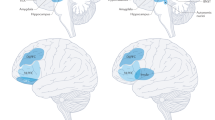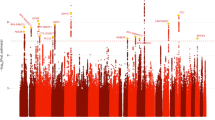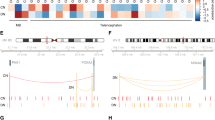Abstract
Drug addiction can be defined as the compulsive seeking and taking of a drug despite adverse consequences. Although addiction involves many psychological and social factors, it also represents a biological process: the effects of repeated drug exposure on a vulnerable brain. The sequencing of the human and other mammalian genomes will help us to understand the biology of addiction by enabling us to identify both genes that contribute to individual risk for addiction and those through which drugs cause addiction. We illustrate this potential impact by searching a draft sequence of the human genome for genes related to desensitization of receptors that mediate the actions of drugs of abuse on the nervous system.
Similar content being viewed by others
Main
To understand addiction, it is important to define the types of molecular and cellular adaptation at the levels of neurons and synapses that account for tolerance, sensitization and dependence, which are often used to define an addicted state. Tolerance describes diminishing sensitivity to a drug's effects after repeated exposure; sensitization describes the opposite. Dependence is an altered physiological state caused by repeated drug exposure, which leads to withdrawal when drug use is discontinued. Each is seen in human addicts and is believed to contribute to continued drug use during addiction1,2. Considerable progress has been made in identifying the molecular and cellular adaptations that mediate these processes3.
Challenges in addiction
A cardinal feature of addiction is its chronicity. Individuals can experience intense craving for drug and remain at increased risk for relapse even after years of abstinence, so addiction must involve very stable changes in the brain. But it has been difficult to identify such changes at the molecular, cellular or circuit levels. The molecular and cellular adaptations related to tolerance, sensitization and dependence do not persist long enough to account for the more stable behavioural changes associated with addiction.
This challenge is analogous to that faced in the field of learning and memory where there has been increasing appreciation for the role of learning-related processes in addiction1,2. Many molecular and cellular models of learning have been discovered and some have been related to simple forms of learning behaviour4,5. But little information is available concerning the molecular and cellular basis of essentially life-long memories. Proposed changes in synaptic structure, or in chromatin organization, remain speculative.
Another challenge is to identify the variations in specific genes that make some individuals vulnerable to addiction and others relatively resistant6. Epidemiological studies indicate that 40–60% of an individual's risk for an addiction, whether it is to alcohol, opiates or cocaine, is genetic. This is consistent with the widely differing sensitivity to drugs of abuse, including preferences to self-administer drug, among inbred rodent strains and lines7. However, we have not identified the specific genes involved in humans or animal models; nor do we understand with any specificity how external factors (including stress or drugs themselves) interact with those genetic variations to produce addiction.
Drugs of abuse seem to cause addiction by acting on evolutionarily old brain circuits. These circuits, which comprise several areas of the limbic system (for example, nucleus accumbens, amygdala and prefrontal cortex), regulate an organism's responses to natural reinforcers, such as food, drink, sex and social interaction1,2. The loss of control that addicts show with respect to drug seeking and taking may relate to the ability of drugs of abuse to commandeer these natural reward circuits and disrupt an individual's motivation and drive for normal reinforcers. There is evidence that ‘natural addictions’, such as overeating, pathological gambling, compulsive shopping and perhaps excessive exercise, may involve analogous mechanisms. A major focus of current research is to explore the neurobiology of these conditions and the influence of genetic factors in their development.
Impact of sequencing the human genome
We now know the initial targets for most drugs of abuse, as well as some of the molecular and cellular adaptations that occur in limbic brain circuits in response to repeated exposure. The draft sequence of the human genome indicates the diversity of the molecular components that have been implicated in addiction. For example, cocaine acts on the re-uptake transporters for dopamine and other monoamine neurotransmitters; we will soon know how many subtypes of such transporters are expressed in humans.
Another example is provided by genes whose products regulate desensitization of G-protein-coupled receptors. Such receptors are the initial targets for several drugs of abuse: opiates are agonists at opioid receptors, cannabinoids are agonists at cannabinoid receptors, and hallucinogens are partial agonists at serotonin 5HT2A receptors. Dopamine receptors, which are indirectly activated by cocaine and other stimulants through potentiation of dopaminergic transmission, are also G-protein-coupled. The sensitivity of G-protein-coupled receptor signalling is controlled by complex regulatory processes (Fig. 1). Given the importance of changes in receptor sensitivity in addiction, it is not surprising that mechanisms governing receptor sensitivity have been implicated in regulating responses to drugs of abuse and in models of addiction3,8,9,10.
Drug-induced adaptations in the efficacy of receptor–Gi coupling could contribute to drug tolerance or sensitization. A possible mechanism is altered phosphorylation of the receptor by GRKs or its subsequent association with arrestins (1). Other possibilities include alterations in G-protein α- (2) or βγ-subunits (3) or in other proteins (for example, phosducin (4) or RGS proteins (5)) that modulate G protein function. Phosphorylation of the receptor by protein kinase A (6) or other kinases represents another potential mechanism. Also shown is agonist-induced receptor internalization, which may be mediated by receptor phosphorylation. From ref. 3.
A critical step in exploring such mechanisms is to identify all of the potential gene products that could be involved. Table 1 shows the results of an analysis of the current human protein dataset for some of the genes that regulate receptor desensitization: G-protein-receptor kinases (GRKs), arrestins, phosducins and regulators of G-protein signalling (RGS proteins). GRKs phosphorylate ligand-bound receptors, enabling association of the receptors with arrestins8,9. This seems functionally to uncouple receptors from their G proteins, perhaps through receptor internalization. Phosducins also appear to alter receptor/G-protein interactions by regulating the availability of G-protein βγ-subunits11. RGS proteins serve as GTPase activating proteins for G-protein α-subunits and thereby alter the kinetics of a receptor-mediated response12.
Our analysis of these gene families reveals new candidate members for each, and in several cases many, which can be investigated for their roles in addiction. For example, the specificity of the GRK–arrestin system for various types of G-protein-coupled receptor is not yet known. Knowledge of the full complement of GRKs and arrestins in humans allows us to evaluate the role of each GRK and arrestin subtype in regulating the sensitivity of the opioid, cannabinoid, serotonergic and dopaminergic receptors implicated in addiction. Similarly, the identification of novel subtypes of phosducins and RGS proteins makes it possible to determine which are expressed in neurons that mediate responses to drugs of abuse and which are involved in longer-term adaptations to drug exposure. Analogous efforts aimed at the receptors and G-protein subunits, as well as the ion channels (for example, inwardly rectifying potassium channels) that are regulated by the G proteins3, will provide more complete understanding of how drugs of abuse alter receptor signalling to produce tolerance and sensitization.
Access to the complete human genome sequence will also help efforts to identify addiction vulnerability genes. One of the major obstacles to such efforts has been the technical difficulty of moving from genetic linkage analyses to identification of specific genes6. The mouse genome sequence will similarly improve the efficiency of identifying addiction vulnerability genes in quantitative trait locus analyses of animal models7.
The power of genomics
Genomics (and the related proteomics) will provide powerful tools to identify the genes and gene products that are altered by repeated exposure to drugs of abuse and by external factors (for example, stress and drug-associated environmental stimuli) that influence the development of addiction. For example, DNA array technology makes it feasible to investigate thousands of gene products simultaneously after drug exposure. By combining genomic and proteomic tools with increasingly sophisticated models of addiction in animals, it will be possible to identify patterns of altered gene expression that are associated with particular features of the addicted state, such as tolerance, sensitization, dependence, craving and relapse.
Detailed analysis of the genome will also reveal how genes are organized and transcribed, and indicate the regulatory elements that control their expression. In addition, such analysis will show the exonic and intronic sequences of individual genes and teach us how to predict their processing into splice variants. We will similarly better appreciate how individual translated proteins are processed into multiple polypeptide products. Knowledge of such rules will greatly facilitate research into addiction. For example, as we elucidate the rules of gene transcription, we may be able to compile a list of genes that are potentially regulated by a transcription factor implicated in addiction, on the basis of the presence of the appropriate response element within their regulatory regions.
Finally, animal models of addiction are well developed, in contrast to other psychiatric abnormalities (for example, depression, bipolar disorder and schizophrenia) for which animal models are less straightforward. As a result, genomic studies of addiction might lead the way in identifying the molecular and cellular basis of complex behavioural states. A better understanding of the biology of addiction should help us to understand the mechanisms underlying symptoms of depression, anxiety and other disorders that overlap with those of addiction. Such understanding might also lead to appreciation of the factors that regulate normal variations in motivation, reward and mood.
References
Koob, G. F., Sanna, P. P. & Bloom, F. E. Neuroscience of addiction. Neuron 21, 467–476 (1998).
Wise, R. A. Drug-activation of brain reward pathways. Drug Alcohol Depend. 51, 13–22 (1998).
Nestler, E. J. & Aghajanian, G. K. Molecular and cellular basis of addiction. Science 278, 58–63 (1997).
Kandel, E. R. Genes, synapses, and long-term memory. J. Cell. Physiol. 173, 124–125 (1997).
Malenka, R. C. & Nicoll, R. A. Long-term potentiation—a decade of progress? Science 285, 1870–1874 (1999).
Nestler, E. J. Genes and addiction. Nature Genet. 26, 277–281 (2000).
Crabbe, J. C., Phillips, T. J., Buck, K. J., Cunningham, C. L. & Belknap, J. K. Identifying genes for alcohol and drug sensitivity: recent progress and future directions. Trends Neurosci. 22, 173–179 (1999).
Zhang, J. et al. Role for G protein-coupled receptor kinase in agonist-specific regulation of mu-opioid receptor responsiveness. Proc. Natl Acad. Sci. USA 95, 7157–7162 (1998).
Bohn, L. M. et al. µ-opioid receptor desensitization by β-arrestin-2 determines morphine tolerance but not dependence. Nature 408, 720–723 (2000).
Potenza, M. N. & Nestler, E. J. Effects of RGS proteins on the functional response of the µ opioid receptor in a melanophore-based assay. J. Pharmacol. Exp. Ther. 291, 482–491 (1999).
Gaudet, R., Savage, J. R., McLaughlin, J. N., Willardson, B. M. & Sigler, P. B. A molecular mechanism for the phosphorylation-dependent regulation of heterotrimeric G proteins by phosducin. Mol. Cell 3, 649–660 (1999).
Berman, D. M. & Gilman, A. G. Mammalian RGS proteins: barbarians at the gate. J. Biol. Chem. 273, 1269–1272 (1998).
Altschul, S. F. et al. Gapped BLAST and PSI-BLAST: a new generation of protein database search programs. Nucleic Acids Res. 25, 3389–3402 (1997).
Smith, T. F. & Waterman, M. S. Identification of common molecular subsequences. J. Mol. Biol. 147, 195–197 (1981).
Pearson, W. R. Searching protein sequence libraries: comparison of the sensitivity and selectivity of the Smith-Waterman and FASTA algorithms. Genomics 11, 635–650 (1991).
Acknowledgements
Preparation of this report was supported by the National Institute on Drug Abuse.
Author information
Authors and Affiliations
Corresponding author
Supplementary information
Rights and permissions
About this article
Cite this article
Nestler, E., Landsman, D. Learning about addiction from the genome. Nature 409, 834–835 (2001). https://doi.org/10.1038/35057015
Issue Date:
DOI: https://doi.org/10.1038/35057015
This article is cited by
-
Custom genotyping for substance addiction susceptibility genes in Jordanians of Arab descent
BMC Research Notes (2012)
-
Organization of rhodopsin molecules in native membranes of rod cells–an old theoretical model compared to new experimental data
Journal of Molecular Modeling (2005)
-
Mining the draft human genome
Nature (2001)
-
Initial sequencing and analysis of the human genome
Nature (2001)
Comments
By submitting a comment you agree to abide by our Terms and Community Guidelines. If you find something abusive or that does not comply with our terms or guidelines please flag it as inappropriate.




